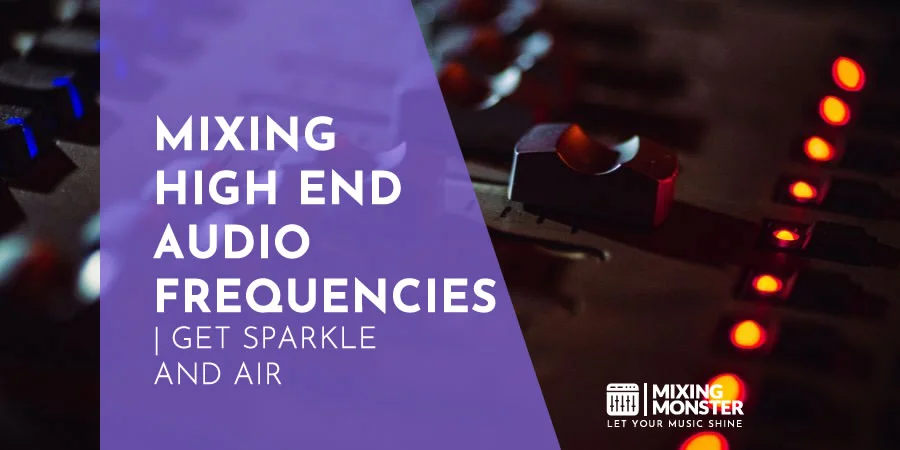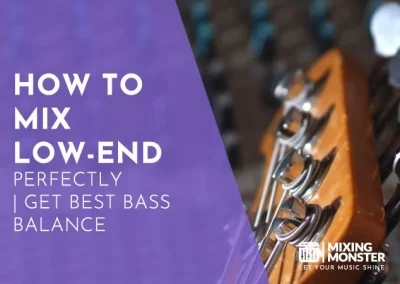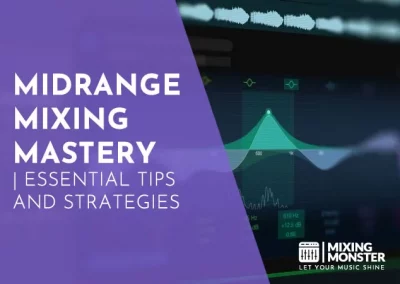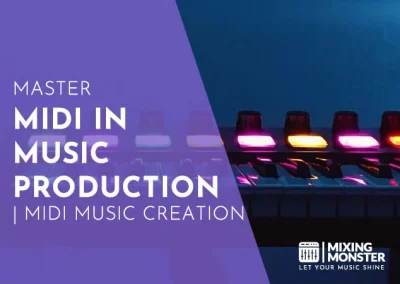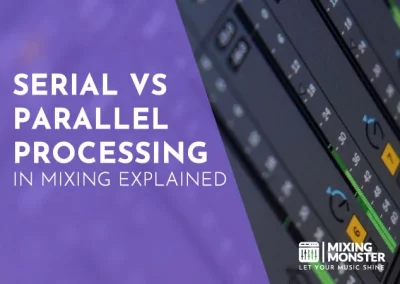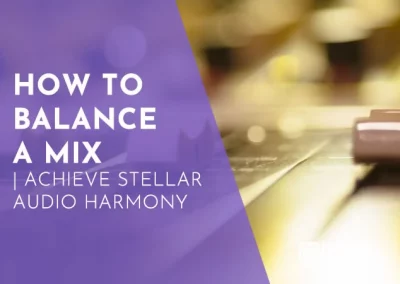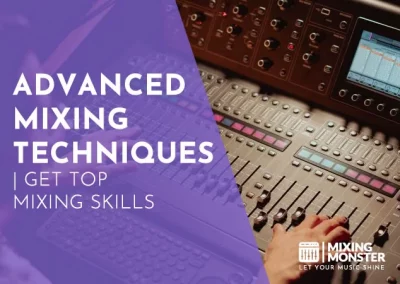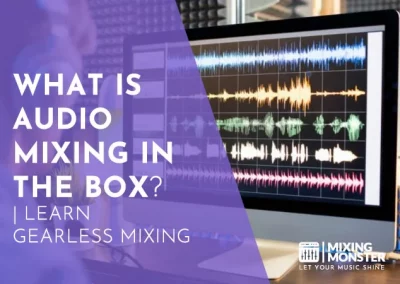Home > Blog > Mixing > Mixing Techniques
Disclosure: Some of the links below are affiliate links, meaning that at no additional cost to you, we will receive a commission if you click through and make a purchase. Read our full affiliate disclosure here.
Mixing high end is a delicate balance that can make or break the clarity and quality of a music track. As you venture into the art of audio engineering, the crystalline shimmer of high frequencies may often seem elusive, but their proper handling is essential for a well-defined mix.
High frequencies grant definition and air to a mix, often carrying the intelligibility of vocals and the sparkle of percussive elements. Adept engineers utilize various techniques to ensure these frequencies contribute to balance and harmony without introducing harshness or fatigue to the listener’s ear. The goal is a blend where high-end elements shine without overpowering the cohesion of the entire sonic landscape.
Discover the nuances of mixing high-end as you navigate through comprehensive insights and tips designed for aspiring and veteran engineers. You’ll learn to define high-end, tackle common challenges, and employ advanced techniques to achieve surgical precision. Understanding the intricacies of high frequencies will empower you to master the art of audio balance, whether your project demands subtlety or bold articulation.
KEY TAKEAWAYS:
- High-end clarity is pivotal for a well-balanced mix.
- Techniques and challenges in mixing high frequencies vary across genres.
- Consistent practice and knowledge lead to mastering high-end mixing.
Table Of Contents
1. Overview Of Mixing High-End Frequencies
2. Defining The High End In Mixing
3. Common Challenges With High Frequencies
4. Advanced Techniques For Surgical High-End Mixing
5. Dynamics Control In The High-End
6. Spatial Processing And The High End
7. Genre-Specific High-End Treatment
8. Best Practices For Mixing High-End
9. Common Pitfalls Mixing High End And How To Avoid Them
10. Mixing High End The Right Way
11. FAQ

1. Overview Of Mixing High-End Frequencies
When mixing audio, the high-end frequencies—typically 6 kHz to 20 kHz—are crucial for adding clarity and perceived brightness to your mix. Strategic enhancement of these frequencies can impart a sense of airiness and sparkle, which helps vocals and instruments stand out.
Understanding The Basics Of High-End Frequencies
The high end of the frequency spectrum governs the details that give your mix clarity and definition. Your vocal tracks and specific instruments, like cymbals or acoustic guitars, rely on this frequency range to cut through the mix and offer a sense of realism and presence. Properly managing these frequencies affects how smooth and polished your final mix sounds.
The Importance Of Clarity, Sparkle, And Air In A Mix
Achieving a perfect balance in the high end can imbue your mix with a sparkle that makes it sound professional and engaging. Techniques such as subtle EQ adjustments and gentle compression can emphasize the airiness of vocals without adding harshness.
This spectral space lets your listeners experience the crispness of hi-hats, the brightness of keyboards, and the nuanced breathiness of singers. Your goal in manipulating this range should be to enhance transparency without allowing any element to become abrasive or to overshadow the rest of your mix.
2. Defining The High End In Mixing
Before we explore the specifics, understand that the high end is a crucial part of the mixing process. It encompasses specific frequencies that, when managed correctly, can make a mix sound polished and professional.
The Frequency Spectrum: Identifying The High End
The frequency spectrum in audio can be divided into three main parts: low-end, midrange, and high-end. These segments correspond to different frequency ranges. The high end, or treble, refers to the uppermost portion of the audio spectrum.
This is where the sharpness and clarity of sounds are found, and it typically includes frequencies from around 6 kHz up to 20 kHz. In this region, you apply equalization (EQ) to shape the tonal balance of your mix.
| Frequency Range (Hz) | Description |
| 6,000 – 10,000 | Presence, ascribed to adding clarity and definition |
| 10,000 – 20,000 | Brilliance and airiness, providing sparkle to the mix |
Characteristics And Role Of High Frequencies In Audio
High frequencies are pivotal in your mix’s perception of brightness and detail. Depending on your goals, they can influence the sense of space and dimension, making elements sound more vivid or subdued.
In particular, vocals occupy a significant space within this range, especially for defining articulation and detail. With sound sources like cymbals or hi-hats, the treble frequencies are where you’ll find much of their characteristic sizzle and shine.
When managing these frequencies, it’s essential to use EQ carefully to prevent fatigue or harshness in the listener. A mix with well-defined high-end should contain clear elements without piercing or overwhelming, maintaining a balance that supports the entire frequency spectrum.
3. Common Challenges With High Frequencies
High frequencies can significantly affect the clarity and perception of your mix. However, managing them requires finesse to avoid common issues that detract from the listening experience.
Balancing Brightness Without Harshness
To achieve a balanced mix, carefully control the high-end to ensure it’s bright and clear without causing listener fatigue. Excessive brightness can lead to harshness, which is particularly distressing with prolonged exposure. For instance, a vocal should be clear, sitting comfortably in the mix without piercing the ears.
- Do:
- Use shelving EQs judiciously to boost the high end.
- Apply a de-esser to temper excessive sibilance in vocals.
- Don’t:
- Overboost high frequencies, as it can make your mix sound brittle.
- Neglect the dynamic nature of high-frequency instruments, which might require compression to sit well in the mix.
Avoiding Masking And Frequency Overcrowding
When multiple elements compete for the same frequency range, they can mask each other, cluttering your mix. Your goal should be to create a powerful mix where each component can be distinctly heard. It’s essential to carve out space for each element to ensure clear separation and prevent masking.
- Identify:
- Instruments with overlapping frequencies apply EQ cuts to allow space for each.
- There are moments where frequency overcrowding might occur and adjust levels or pan to clarify.
- Implement:
- Strategic notch filtering where masking is occurring.
- Sidechain compression techniques to duck competing elements dynamically.
Attention to these details can avoid common pitfalls and achieve a polished, professional-sounding mix.
4. Advanced Techniques For Surgical High-End Mixing
In this section, you’ll learn how to apply precise adjustments and enhancements that elevate the high end of your mix. These techniques involve surgical EQ, harmonic excitement, and sophisticated analysis tools.
Equalization: Precision And Selectivity
Equalization is essential for sculpting the high-end. You’ll want to use an equalizer with a high Q-factor for narrow boosts or cuts, focusing on frequencies that provide air and clarity to instruments like vocals. Remember, it’s not just about boosting; strategic attenuation can remove harshness and create space in your mix.
Harmonic Excitement And Saturation Tools
Employing saturation or harmonic excitement can add life to dull sounds. Use digital or hardware saturation tools judiciously to introduce warmth and presence. Moderate saturation levels on higher frequencies can shimmer your vocal tracks without overwhelming the mix.
Utilizing High-Resolution Equalizers And Analyzers
High-resolution equalizers and analyzers are imperative in modern mixing workflows, whether in software or hardware form. They allow for micro-adjustments and a clear visual representation of the processing happening in real time. Apply these tools to ensure your high-end is well-balanced and free of unwanted artifacts.

5. Dynamics Control In The High-End
Controlling the dynamics within the high-frequency range ensures clarity and presence without introducing harshness or sibilance. This section focuses on techniques to manage these dynamics through selective compression.
Compression Strategies For High Frequencies
When mixing the high end, it’s crucial to apply compression carefully to maintain the natural quality of the sound while controlling peaks. For high frequencies such as cymbals or vocals, gentle compression settings can prevent sharp transients from piercing through the mix.
A strategy is to set a compressor with a fast attack to catch the peaks and a moderate release to avoid unnatural pumping effects. Using a compressor with a sidechain filter allows compression that reacts precisely to the high frequencies, ignoring the lower content that doesn’t require control in this context.
The Use Of Multiband Compression And De-Essing
Multiband compression divides your audio signal into separate bands, enabling you to compress the high end independently from the mids or lows. This precise technique allows for targeted, dynamic control where issues such as sibilance reside.
When you notice harshness in the vocal high end, a de-esser can be invaluable. As a frequency-specific compressor, it effectively reduces sibilance by isolating and attenuating frequencies typically between 5 and 8 kHz.
Incorporating dynamic EQ can be an alternative or supplement to multiband compression. Dynamic EQ applies gain reduction only when specific frequencies exceed the threshold, allowing for a more transparent approach to managing dynamic content within the high end.
6. Spatial Processing And The High End
The high end holds significant power in sculpting spatial awareness and dimension. Your processing choices here should enhance depth and maintain the integrity of the stereo image without clouding the mix.
The Role Of Reverb And Delay On High Frequencies
Using reverb wisely can add depth and space to high-end elements, like cymbals or acoustic guitar strings, by simulating how sound behaves physically. Key parameters:
- Pre-Delay:
Determines the time gap before the reverb tail starts, separating the dry signal and the reverberated sound, which aids in preserving clarity. - High-Frequency Damping:
Controls the absorption of high frequencies; less damping retains more air and brightness in the reverb tail.
Alternatively, strategic use of delay can reinforce the presence of high-frequency content. For example, a bright, tight delay on a vocal can add a sense of expansiveness without muddying the mix.
Creating Depth While Maintaining Clarity
To ensure depth without sacrificing clarity:
- EQ:
Apply high-pass filtering on reverbs and delays to prevent low-frequency buildup that can clutter the high end. - Stereo Placement:
Use panning to position high-frequency elements, helping to create a stable stereo image; this must be done judiciously to avoid an imbalanced mix.
Careful dynamics processing is vital. For instance, a de-esser or dynamic EQ can tame harshness in the high frequencies, allowing for a more polished spatial effect. It’s crucial also to balance the level of these processed signals to ensure they enhance, not overpower, the mix’s high-end detail.
7. Genre-Specific High-End Treatment
Mastering the high end in your mix can drastically differ across musical genres, each with its challenges and techniques to ensure clarity without sacrificing balance.
Mixing High End In Electronic Music
Electronic music often thrives on a pronounced high end to deliver its characteristic sheen and sparkle. EQ sweeps are essential to pinpoint and alleviate harsh frequencies without creating fatigue.
Effective sidechain compression can also help balance the high end and the rest of your frequency range, allowing kick drums and basses to pump through without overpowering the high-end detail.
Handling High Frequencies In Rock And Pop
Rock and Pop must carefully mix high frequencies to ensure each element sits nicely in the mix. For guitars and cymbals, slight boosts around 6-8 kHz can enhance presence, but be wary of adding too much to avoid muddiness.
Utilizing multiband compression in moderation can help tame the high-end dynamics, thus providing a smooth and controlled sound. EQ is your ally here; a gentle high-shelf adjustment can bring clarity to vocals without harshness.
Considerations For Jazz And Classical Genres
In Jazz and Classical music, the high end is about clarity and naturalness. Avoid aggressive EQ; instead, aim for transparent adjustments that respect the acoustic space and original instrument tones.
Due to these genres’ expansive frequency range and dynamic nature, minimal compression is often better. High-end detail should be treated with subtlety to preserve the dynamics and nuances inherent in these styles.
Your EQ choices should support and not overshadow acoustic instruments’ natural breath and resonance.
8. Best Practices For Mixing High-End
Mixing high-end requires attention to detail and a critical ear. These best practices are designed to help you achieve clarity and balance in the treble frequencies of your mixes.
Monitoring And Listening Environments
Your monitoring system and listening environment profoundly affect your high-end mixing decisions. Use speakers and headphones that provide an accurate and flat frequency response. Treat your listening space to minimize reflections and standing waves, as these can color the sound and lead to misjudgments regarding high frequencies.
Reference Tracks And A/B Testing
Incorporate the use of reference tracks that are professionally mixed and represent the sound you’re aiming for. Regularly toggle between your mix and the reference tracks to A/B test the high end. This practice helps to match the quality of your mix to industry standards and maintains a consistent listening experience.
The Art Of Subtractive EQ
Subtractive EQ is central to a clean mix. Reducing problematic frequencies is often more effective when addressing the high-end than boosting others. This method can prevent harshness and allow other elements to shine through. Practice pinpoint volume automation to handle sibilance without affecting the energy of your vocals.
Best Practices For Mixing High End:
- Calibrate your studio monitors and headphones for a flat response.
- Treat your room acoustically to minimize misleading reflections.
- Consistently use reference tracks to guide your EQ decisions.
- Employ A/B testing for an accurate comparison with professional mixes.
- Execute subtractive EQ to mitigate harshness and maintain headroom.
- Implement volume automation carefully to address sibilance in vocals.
9. Common Pitfalls Mixing High End And How To Avoid Them
Understanding the intricacies of the high end in a mix is crucial. Addressing issues like over-EQing and phase to prevent harshness and listener fatigue will enhance the clarity and quality of your mix. Keep volume levels in check to maintain the balance across the frequency spectrum.
Over-EQing And Phase Issues
Avoid the temptation to over-EQ. High frequencies are susceptible to EQ adjustments. Over-EQing can cause phase issues, leading to a mix that feels unnatural or thin. Utilize minimal and targeted EQ boosts or cuts to enhance clarity without affecting the overall phase coherence.
High-End Buildup And Listener Fatigue
When multiple elements compete in the high end, it results in harshness and listener fatigue. To prevent buildup, prioritize elements that need emphasis in the high frequencies and use subtractive EQ to make space. This will keep your mix clean and reduce the risk of fatigue over extended listening sessions.
Mixing At Appropriate Volume Levels
Mixing at excessively loud volumes can deceive your ears, particularly at the high end. Keep monitoring volume at moderate levels to ensure a balanced mix across the frequency spectrum. This practice helps make sound decisions when EQing and prevents misleading representation of high-frequency content.
10. Mixing High End The Right Way
When mixing high-end, you focus on clarity and balance without overpowering the mix. It’s essential to apply effective techniques to enhance the listening experience while maintaining the natural characteristics of the original sound.
Fundamental Techniques And Strategies For Mixing High-End
- Selective EQ:
Utilize a high-frequency shelf to accentuate or attenuate the high end. Being selective is crucial; boost the desired elements like a vocal track only where necessary to make it stand out without affecting the entire mix drastically. - Dynamic Compression:
Apply compression with a light touch to manage the peaks in the high frequencies. Remember that over-compression can lead to a flat and lifeless sound. - A/B Testing:
Regularly compare your high-end mix to the untreated version or a reference track. This will help you maintain the right balance and maintain perspective. - Moderation In Effects:
Reverb and delay can enhance the high end but in moderation. Too much can wash out your mix and muddy the clarity you strive for. - Critical Listening:
Pay close attention when mixing high-end, as small changes can significantly impact. Use quality headphones or monitors in a well-treated room for the most accurate listening experience.
Focusing on these critical techniques and strategies ensures high frequencies enhance the mix, providing a polished and professional result.
Happy high-end mixing!
11. FAQ
1) What are high-end audio frequencies, and why are they essential in mixing?
High-end audio frequencies typically refer to the upper part of the sound spectrum, generally from around 6 kHz to 20 kHz. These frequencies are critical in mixing because they add “sparkle” and “air” to the sound, helping to provide clarity and definition, particularly for vocals and percussive elements. Properly mixed, high frequencies can significantly enhance the detail and presence of a track.
2) How can I prevent excess high frequencies from overpowering my mix?
Exercise restraint with EQ boosts to prevent high frequencies from dominating your mix, and consider using high-shelf filters sparingly. Employ dynamic EQ or multiband compression to tame the peaks without affecting the overall energy of your track.
3) What are the essential techniques for practical EQ application in mixing the high-end?
Effective EQing at the high end requires a subtle approach; often, cutting is more beneficial than boosting. Pay attention to removing resonant peaks and employ a high-pass filter to clean up any unnecessary low-end rumble that can cloud your high frequencies.
4) What strategies are recommended for mastering audio without causing unintended cuts in high frequencies?
When mastering, the goal is to preserve the integrity of your mix’s high-end. Use linear-phase EQ to avoid phase issues, and be mindful of de-essing only when necessary to maintain brightness and detail without introducing sibilance.
5) How can one address a harsh-sounding mix and achieve a more balanced sound?
A harsh mix can often be softened by locating and attenuating problematic frequencies in the 3-5k Hz range. Automating EQ adjustments or dynamic processing can help balance these areas dynamically throughout your mix.
6) What methods enhance clarity in high-end frequencies during the mixing process?
Consider using gentle boosts with a broad Q in the upper frequencies to enhance clarity at the high end. This can add airiness without harshness. Careful attention to stereo placement and panning can ensure each element sits nicely in the mix, allowing for a clearer high end.

